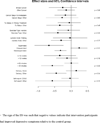Exercise effects on depressive symptoms in cancer survivors: a systematic review and meta-analysis
- PMID: 22068286
- PMCID: PMC3253916
- DOI: 10.1158/1055-9965.EPI-11-0634
Exercise effects on depressive symptoms in cancer survivors: a systematic review and meta-analysis
Abstract
Background: Depression is a distressing side effect of cancer and its treatment. In the general population, exercise is an effective antidepressant.
Objective: We conducted a systematic review and meta-analysis to determine the antidepressant effect of exercise in cancer survivors.
Data sources: In May 2011, we searched MEDLINE, PsycInfo, EMBASE, CINAHL, CDSR, CENTRAL, AMED, Biosis Previews, and Sport Discus and citations from relevant articles and reviews.
Study eligibility criteria: We included randomized controlled trials (RCT) comparing exercise interventions with usual care in cancer survivors, using a self-report inventory or clinician rating to assess depressive symptoms, and reporting symptoms pre- and postintervention.
Study appraisal: Around 7,042 study titles were identified and screened, with 15 RCTs included.
Synthesis methods: Effect sizes (ES) were reported as mean change scores. The Q test was conducted to evaluate heterogeneity of ES. Potential moderator variables were evaluated with examination of scatter plots and Wilcoxon rank-sum or Kruskal-Wallis tests.
Results: The overall ES, under a random-effects model, was -0.22 (confidence interval, -0.43 to -0.09; P = 0.04). Significant moderating variables (ps < 0.05) were exercise location, exercise supervision, and exercise duration.
Limitations: Only one study identified depression as the primary endpoint.
Conclusions: Exercise has modest positive effects on depressive symptoms with larger effects for programs that were supervised or partially supervised, not conducted at home, and at least 30 minutes in duration.
Impact: Our results complement other studies showing that exercise is associated with reduced pain and fatigue and with improvements in quality of life among cancer survivors.
Conflict of interest statement
Figures
References
-
- Massie MJ. Prevalence of depression in patients with cancer. J Natl Cancer Inst Monogr. 2004:57–71. - PubMed
-
- Haisfield-Wolfe ME, McGuire DB, Soeken K, Geiger-Brown J, De Forge BR. Prevalence and correlates of depression among patients with head and neck cancer: a systematic review of implications for research. Oncol Nurs Forum. 2009;36:E107–E125. - PubMed
-
- Pirl WF. Evidence report on the occurrence, assessment, and treatment of depression in cancer patients. J Natl Cancer Inst Monogr. 2004:32–39. - PubMed
-
- Deschields T, Tibbs T, Fan MY, Taylor M. Differences in patterns of depression after treatment for breast cancer. Psychooncology. 2006;15:398–406. - PubMed
-
- Honda K, Goodwin RD. Cancer and mental disorders in a national community sample: findings from the national comorbidity survey. Psychother Psychosom. 2004;73:235–242. - PubMed




